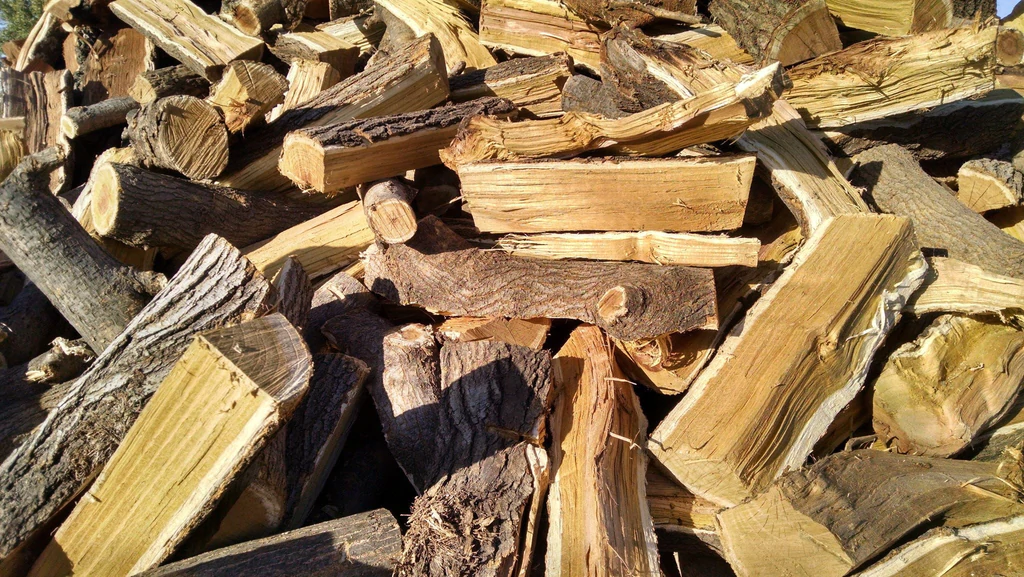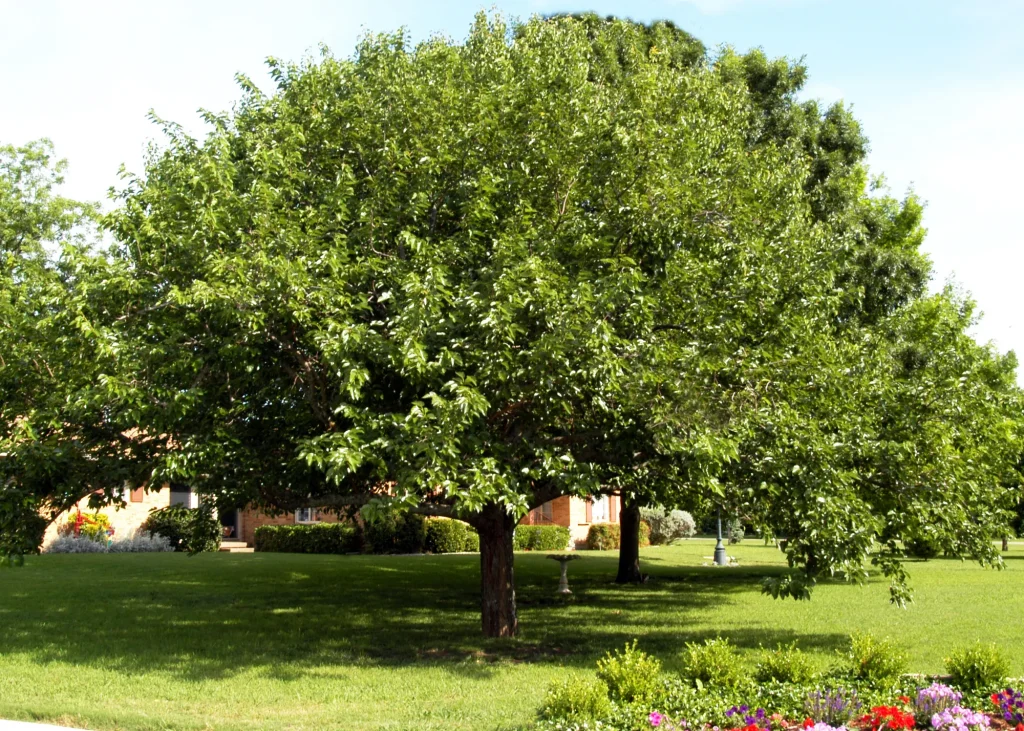Mulberry firewood is of excellent quality with high heat production, fast seasoning time, easy to split, and a pleasant smell. One of its main disadvantages is the low yield per tree and the lower availability. It also has a moderate smoke generation compared to top-tier firewood like oak.
I have never found more than one or two dead mulberry trees on offer, which I am happy to process. However, they are not often available in enough quantity that you can stockpile two or three cords worth for your winter requirements.
Mulberry wood is beloved among firewood enthusiasts, and you are in for a great time if you can get your hands on some.
Table of Contents
Summary
- BTU: 26 million BTU/cord
- Weight: 4700 lb/cord green
- Seasoning Time: 12 months
- Splitting Difficulty: Easy
- Sap Content: Low
- Smoke: Moderate
- Smell: Pleasant, Sweet, and Smokey
Overall, mulberry is excellent firewood with top-tier heat production and is easy to split. It has low sap content and seasons quickly for hardwood at around one year. The wood has a very high density, so you don’t need to stockpile as much as you would for a softwood alternative.
However, it does have some disadvantages, such as its moderate smoke generation. A mulberry tree also doesn’t grow very tall or wide, so the firewood yield per tree is low. You will rarely find enough mulberry firewood available for your entire winter stockpile, so you may need to blend it with another hardwood.

Heat Production
Mulberry wood is in the top tier of heat-producing firewood, along with oak and maple. Mulberry is in the top 10 highest heat-producing firewood in the US. It is ideal for warming your home all winter or your campsite outside.
They also produce great coals for cooking that will last all night. This combination of high heat per log and the coals will slowly continue to burn all night. I find mulberry is excellent for cooking as you get a stable temperature.
The wood also has a very low sap content, so you won’t find any cracking or popping when you burn it.
Smoke Production
Mulberry wood has a reputation for a smokier burn than oak. I think this is partly due to the high moisture content of green mulberry. In my experience, if you have seasoned it correctly and reduced the moisture content below 20%, then the smoke generation is minimal.
If you are going to burn it indoors in your wood stove, I recommend having a glass screen installed and sufficient ventilation to ensure you don’t smoke out your house.
Seasoning Time
Mulberry wood seasons relatively quickly compared to hardwood at 12 months. This depends on your location and weather, as well as the design of your firewood storage. Cutting your logs into smaller pieces and increasing the airflow through the stacks will reduce the seasoning time.
Mulberry wood doesn’t grow into giant trees like oak, so the firewood pieces will generally be smaller. This is one of the reasons that the wood seasons faster. It also has a low sap content, so you don’t need to wait for the sap to clear the wood.
I personally recommend this General Tools Moisture Meter. It allows you to accurately gauge how wet your firewood is and whether it is sufficiently seasoned. Over time you can also see how quickly the moisture is dropping and how much longer you need to keep your firewood dropping until it is seasoned and ready to burn.
Press the sharp pins into the wood and you will quickly see the readout show the moisture ranging from 5% to 50%. It also has a Low/Mid/High indication depending on whether the wood is dry enough, so you don’t need to remember the actual values.

Burning Smell
Mulberry firewood has a great smell that I would describe as a more subtle form of hickory. I don’t put it in the same category as a cherry wood, but it is undoubtedly in the second-highest tier. Mulberry has a higher sugar content than other hardwoods, which is where its smell comes from.
I would describe the smell as both smokey and sweet. It is not strong enough that having an entire fire built from mulberry can be overwhelming. I have heard from some people that they don’t like the smell of mulberry wood, so try it for yourself before you buy an entire cord.
If you are especially interested in odor for smoking meats or if you are sensitive to smell, have a read through this guide I have written about the best smelling firewoods to burn.
Creosote Buildup
Creosote is a soot buildup that can form in your chimney due to unburnt wood. This is much more prevalent in unseasoned softwood. Green pine is the worst wood you can burn for creosote buildup. I recommend cleaning your chimney annually, regardless of the wood you burn to eliminate the risk of chimney fires completely.
Mulberry doesn’t produce a lot of creosote when burnt, as long as it is seasoned correctly. Don’t be tempted to burn mulberry until the moisture content is less than 20%, or you will see the smoke generation that some people complain about.
Splitting
Mulberry wood is easy to split. I would put it in the same category as oak firewood. The individual trees are also relatively small, so you don’t get a large yield of firewood per tree. It is unlikely you will need a log splitter unless you have somehow found several trees to process.
You may be tempted not to split the trunk of the mulberry tree because the log is already thin, but I suggest you do to help with the seasoning process.
Different Types/Species
Three main species of mulberry tree are grown commercially in the United States – red, black, and white. Each of these varieties has its own characteristics that make them unique.
Red Mulberry
Red mulberry trees are mostly found in the Eastern US states.
- Heat Production: 26 million BTU/cord
- Height: 40 feet
Black Mulberry
Black mulberry trees are the shortest and slowest growing species, primarily found in the southern United States.
- Heat Production: 26 million BTU/cord
- Height: 30 feet
White Mulberry
White mulberry is the most common species of mulberry tree in the United States. It is fast-growing, and its leaves are used for silkworms.
- Heat Production: 26 million BTU/cord
- Height: 50 feet

Comparison to Other Woods
Here, I’ve taken some of the most popular firewoods to burn indoors and compared them to mulberry firewood.
Mulberry firewood makes my list of the top 5 hardwood options. It has a high heat production, has a high density, and makes excellent coals. It is easy to split, and seasons very quickly. Its disadvantage is that it can generate some smoke if not seasoned correctly.
If you can get your hands on some mulberry wood, then grab it quickly.
| Firewood | Million BTU/Cord (source) | Ease of Splitting | Coals | Overall Quality |
| Green Ash | 20 | Easy | Good | Excellent |
| Maple | 25 | Easy | Excellent | Excellent |
| Bur Oak | 26 | Easy | Good | Excellent |
| Mulberry | 26 | Easy | Excellent | Excellent |
Mulberry wood also has a high density, so you can fit more tonnage within a cord stockpile volume.
FAQs
Can you burn mulberry wood in a fire pit?
Yes, mulberry firewood is ideal for burning outdoors. It can produce moderate smoke if it is not fully seasoned. Mulberry is one of my top firewood options, but the thin diameter tree means you may need to add more logs at a higher frequency. It also produces high-quality coals that burn slower and produces a stable temperature ideal for cooking.
Can you burn mulberry wood in a wood stove?
Yes, mulberry wood is ideal for heating your home in a wood stove. It has a high heat production and burns slowly, all night. There are reports of a moderate smoke generation, but I have only experienced this with unseasoned wood. Use a moisture meter to ensure you are not unknowingly burning unseasoned mulberry wood.
How much does mulberry firewood cost to buy?
Mulberry firewood costs similar amounts to other hardwood at $300 to $400 per cord. However, it is generally less available than other wood species because it is primarily grown commercially for the berries. It also has a lower yield per tree, so it does require many trees to fill up your winter stockpile.
Final Thoughts
Mulberry wood is one of my top five firewoods due to its unbelievable combination of high heat production, fast seasoning, pleasant smells, and easy to split. Its main disadvantages are its availability and the low yield per tree. The thin diameter of the trunk means that you can never find a large log that will burn all night, and you will need to add mulberry logs at a higher frequency than oak.
The coals produced are of an excellent quality that produces a stable temperature I have found is ideal for cooking. Whenever I hear of a dead mulberry tree available, I smile as I drive to fell and process it. Never pass up an opportunity to add mulberry wood to your stockpile.
